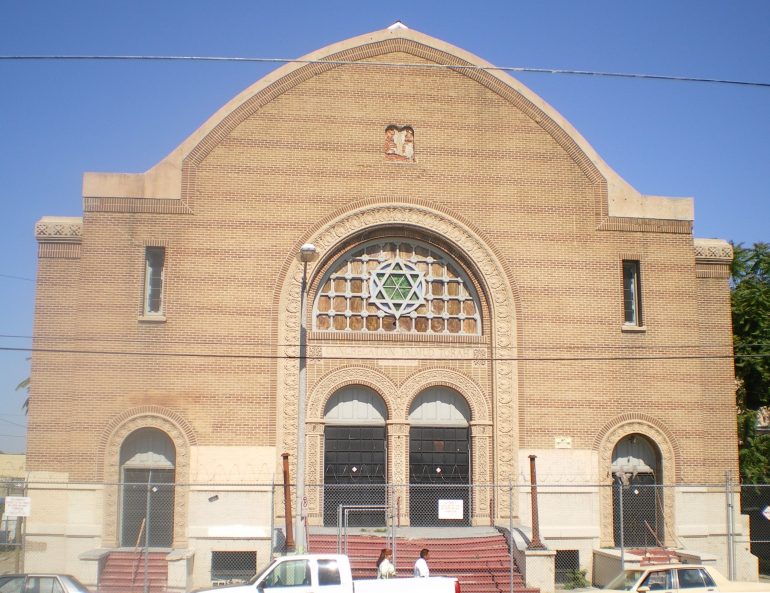Most of us are familiar with Los Angeles’ Jewish-inhabited areas, including La Brea, Fairfax, and Pico-Robertson. These neighborhoods house multitudes of kosher restaurants, markets, and shops. However, most Jews who live in Los Angeles are not aware of how the city’s first Jewish community developed.
UCLA’s Alan D. Leve Center for Jewish Studies presented an exhibition of the history of Los Angeles’ first Jewish community in the main street of Boyle Heights, called Brooklyn Avenue. An elaborate timeline at the exhibition beautifully demonstrated the development of this land.
In order to fully understand the growth of this multicultural community, we need to move back to the 1850’s when Andrew Boyle, an Irish immigrant, purchased land in El Paredon Blanco, California. At this time there were eight Jewish businessmen living within this 22-acre area.
After the passing of Andrew Boyle in 1871, his son-in-law, William H. Workman, inherited the property and divided it into inhabitable areas. He called the settlement “Boyle Heights” in memory of his father-in-law. Soon after, the Brooklyn Land and Building Company formed an additional 105 acres of inhabitable land and name it “Brooklyn Heights,” aiming to attract migrants from the east coast.
This new land was underdeveloped due to the difficulty accessing water and transportation into the city. The land had a minimal number of Jewish inhabitants as well as a mixture of other ethnic groups, but this slowly changed. Workman was determined to convince City Council to develop an accessible water source in Boyle Heights, and he even ran for office when his lobbying efforts failed. Near the end of the 1870’s, the City Council complied with Workman’s requests and built pipelines, bridges, and it’s first rail system.
In 1881, after Tsar Alexander II was assassinated, Jewish communities were physically attacked by mobs (known as “pogroms”) and were refused opportunities in work, education, and development. These conditions triggered the relocation of 2.5 million Jews to the United states by 1924.
Thousands of eastern European Jews migrated to the United States but their opportunity to buy land was limited due to the redlining of neighborhoods. This meant that banks in certain areas would refuse to give out loans to any “colored” individuals including Jews, Latinos, and African Americans. Some of the few properties open for Jews to buy were those in Boyle Heights, specifically on Brooklyn Avenue. Boyle Heights eventually grew to house one of the world’s largest Jewish communities.
In 1904, the first Talmud Torah, a religious school, was developed and later also became the major synagogue. Additionally, organizations were developed to help immigrants settle into their life in America and to assist European Jews in maintaining their Yiddish culture.
The Bikur Cholim Society, a Jewish organization supporting the sick, opened a medical facility called Mt. Sanai Home for Chronic Invalids. Also, the first kosher deli, Canter Brothers, opened on Brooklyn Avenue. It finally moved to Fairfax Avenue in 1950. The Jewish community in Boyle Heights was also involved in activism. In 1934, organizations formed to raise awareness of Hitler’s Jewish persecution in Europe by boycotting German made foods.
Although most Jewish Immigrants were literate in English, they chose to speak in their mother tongues (“mam lashon”), which was Yiddish. The community hosted vibrant literature and art: Jews wrote poetry that expressed their struggles in fitting into American society, and in general, much of their works reflected their Yiddish culture and Jewish identity.
The exhibit also presented artifacts and photos of the first major Jewish synagogue in Los Angeles, Congregation Talmud Torah. One of the artifacts included a shtender, a beautifully designed stand used for the Rabbi’s notes when addressing his congregation. There were pamphlets from religious events and other notices expressing the society’s political beliefs.
Professor Saba Soomekh, who guided me through the exhibit, explained that Jews left Boyle Heights after President Roosevelt came into office because he removed the redlining of neighborhoods. The removal of these restrictions, she told me, allowed the Jewish community to move into the Fairfax district, which houses many Ashkenazim today.
In 1994, Brooklyn Avenue was renamed Avenida Ce’sar Cha’vez, after a civil rights leader and labor activist.
The Jews of Brooklyn Avenue migrated to a desolate and underdeveloped piece of land and built a community that devoted itself to helping each another. They expressed their deep cultural beliefs through their organizations, literature, and art. There is no question that the people of Brooklyn Avenue were the foundation for the development of the thriving Los Angeles Jewish community of today.

